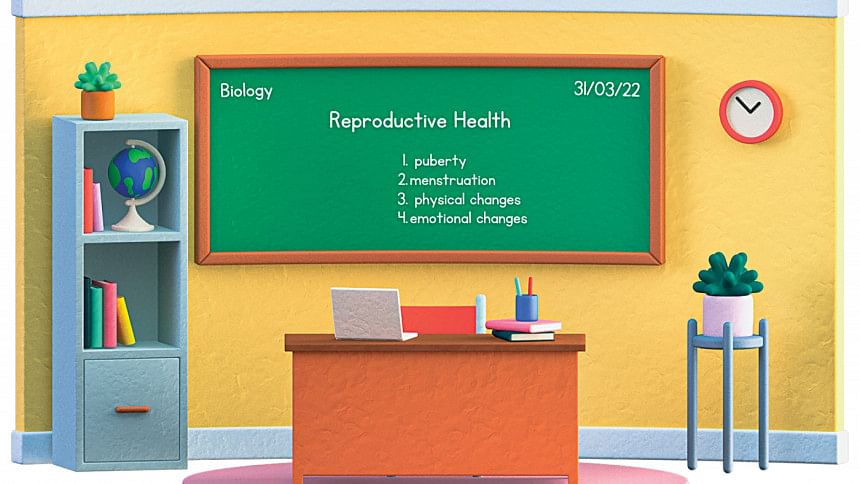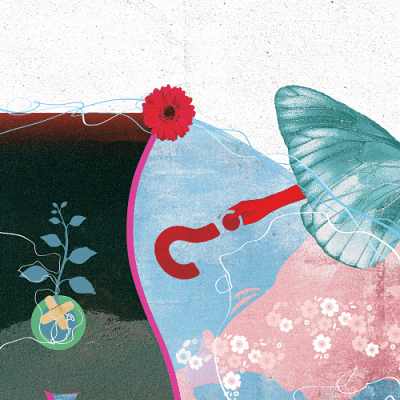Dazed and confused

"I had never really put much thought into what reproductive health is and this interview is the first time I actually decided to Google what the term really means."
This was the response I received from 18-year-old A Level candidate Eliza Tahmida Sultana, when asked about what she knew about the topic of reproductive health.
This is a tale as old as time. Lack of information regarding an important developmental aspect of one's life leading to helplessness and confusion.
According to a report published by UNICEF, one-fifth of Bangladesh's population is comprised of adolescents. Despite being such a large portion of the population, there is lack of services tending to their health problems. Adolescents in our country still have limited knowledge about reproductive health issues and limited access to accurate information. And while textbooks and curriculum include content about reproductive health, schools and teachers are by and large reluctant to teach these topics. As a result, the majority of adolescents have no idea about the changes associated with puberty (e.g. menstruation or wet dreams) until they experience them.
When it comes to any sort of education on reproductive health, 17-year-old O Level candidate Shanum Sarkar shared, "We had very strictly educational Biology classes from 10th grade. Before that, we were not even allowed to flip through the reproduction chapter in our books." She further adds how bizarre it was since many girls would start going through puberty at the age of nine.
This seemed a common response from the various teenagers interviewed for the article where education of reproductive health by schools was restricted to the pages of the Biology books only, and the teenagers ended up merely learning bookish knowledge of the reproductive organs but nothing about their reproductive health.
Besides schools, the other place where adolescents seek information from is their parents, but the scenario there also seems to be bleak for the majority of the teenagers.
"I didn't know about menstruation until fourth grade when a classmate told me about it, and all she knew about it was that it was a normal phenomenon and that it 'happens to every girl'. When I got my first period, I was just handed sanitary napkins and was taught how to dispose of them and that was the extent of the information I received. I was not told what colours or changes in the consistency of my period might indicate or what not having it at some point might mean. I also wasn't sure how children were conceived until seventh grade and the way I learned that definitely isn't commendable," mentioned 18-year-old Fabiha Afifa, student at Maple Leaf International School.
The last resort for these teenagers when it comes to receiving information about their own bodily issues would be healthcare providers. Even there, dispersing relevant information seems to be hurdled with stigma and proper information regarding reproductive health seem to be confined to married individuals only. Doctors are often visibly reluctant on sharing pertinent information with adolescents.
For Shanum, an undiagnosed eating disorder-related issue leading to disruption in her menstrual cycle had required her to visit a gynaecologist.
"The first thing the doctor asked me was my marital status. Considering I was 13 or 14 years old back then, I found the question to be quite absurd and it made me wonder why they couldn't just ask if I was sexually active," she recalled.
Apart from the lack of knowledge about tending to their own reproductive health, puberty itself becomes a confusing period to navigate through for many. With so many changes taking place in their bodies, many find it hard to understand which changes are normal and which ones aren't. Although many of the adolescents spoken to for the article did seem to have a solid grasp of the biological basis of puberty, they still struggled to cope with the changes themselves not having an adult with the proper knowledge to walk them through this difficult time period.
"During my puberty, I suffered from insecurity because I had hair growing in places where girls don't usually have hair," commented Eliza, adding that it was a hormonal issue but she felt the need to cover these hairs out of embarrassment. On the other hand, Shanum disclosed how acne during her teenage years and a growth spurt that everyone would point out had made her feel ashamed and uncomfortable.
But, if not from schools, homes, or healthcare providers, where were these teenagers getting their information from? It seemed social media posts and Google searches were their main teachers. For youths barely starting to traverse the big bad world of the internet, this clearly is not a sustainable option.

For male adolescents, the situation seems slightly direr with an even lower level of awareness regarding male reproductive health. Many female participants spoken to also had the idea that reproductive health was confined to the females.
This idea was reiterated by 15-year-old O Level candidate Inqiad Bin Ali's response, where he said, "Personally, I thought reproductive health is related to the processes that lead to conception and hence initially, I used to think it was only relevant to women. But I later found out, due to my own puberty and Biology lessons, that men have a lot to learn as well."
Although being just as confusing, the experiences of male puberty are slightly different than that of a female.
"I was aware that growing a beard was a common phenomenon during puberty but that's something that has not happened to me yet. My first ejaculation was a terrifying experience for me. The growth of hair from around my genitals and armpits made me feel embarrassed as well," Inqiad goes on to share his experience going through puberty. He also shared how he kept all these facts hidden due to shame.
Shame regarding these changes is not uncommon and the stigma surrounding reproductive health seems to keep coming down to this idea of shame. This shame disrupts conversation about topics of reproductive health which further leads many adolescents to have undiagnosed health complications.
In a recent study by Kamrul-Hasan, ABM et al., polycystic ovary syndrome (PCOS) is an emerging problem for Bangladeshi adolescents with 88 percent of the patients involved in the study having oligomenorrhea, 2.3 percent having primary amenorrhea, 6.9 percent having secondary amenorrhea, and 2.9 percent having polymenorrhea. The lack of understanding and knowledge also leads these adolescents to conceal the most basic bodily function.
Puberty for 17-year-old Aryana Zaman* studying at Bangladesh International Tutorial (BIT) started at the age of nine. "The first time I got my period, I thought it was some kind of a disease resulting from dehydration. I was pretty scared at first and thought I was going to die. I hid the situation from my family for the first two days but obviously, they soon found out. And, although my family was supportive, I don't think I received enough information about the whole process and I was even told to hide my menstruation from my friends and teachers," she said.
The stigma is further extended to adolescents not conforming to the binary identities of males and females as most healthcare services are designed in a very binary manner. This population ends up facing unique barriers to receiving care due to being so vastly under-researched, according to Moseson et al.
It is crucial to impart proper knowledge to adolescents regarding their bodily changes. According to Inqiad, "If society had taught me about the physical and emotional changes I would go through during my teens, puberty would have been a lot easier to handle. Moreover, I would have been able to steer clear of harmful misconceptions."
*Name has been changed for privacy.
References
1. Population Council. (2004). Improving Reproductive Health of Adolescents in Bangladesh.
2. TouchREVIEWS in endocrinology. (2021). Clinical, Metabolic and Hormonal Profiles of Bangladeshi Adolescents with Polycystic Ovary Syndrome.
3. Obstetrics & Gynecology. (May 2020). The Imperative for Transgender and Gender Nonbinary Inclusion.
Tasnim Odrika has only one personality trait and that is cats. Share ideas for new personality traits with her at [email protected]

 For all latest news, follow The Daily Star's Google News channel.
For all latest news, follow The Daily Star's Google News channel. 








Comments